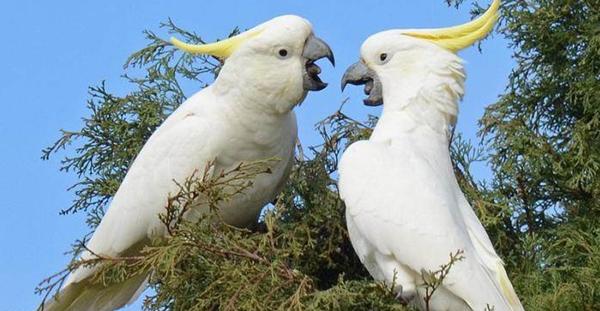Indonesia are famous among local and international tourist for its richness in people, cultures, and natural resources since long time ago. Having those various range of floras and faunas living in here can be one of the magnetic factors on why people are willing to go across the globe to experience and see them with their own eyes.
When you plan on visiting Indonesia, here we present to you, several common birds in Indonesia that has beautiful features on themselves you might want to see yourselves:
1.Celepuk Siau (Otus siaoensis)
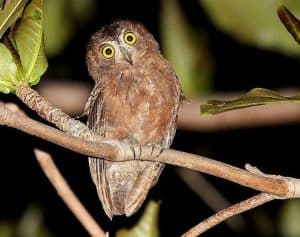 Celepuk Siau is one kind of Stringidae owls that live endemically in Siau island, North Sulawesi. This species is classified as endangered animal and only less than 50 heads live left.
Celepuk Siau is one kind of Stringidae owls that live endemically in Siau island, North Sulawesi. This species is classified as endangered animal and only less than 50 heads live left.
Just like any other owls, Celepuk Siau is nocturnal that actively alive at night. Read more about Common Flowers in Indonesia, Common Trees in Indonesia, Effects of Deforestation in Indonesia
2. Anis-bentet Sangihe (Colluricincla sanghirensis)
 This is small species of bird that live happily around Sahendaruman mountain, endemically in Sangihe island, North Sulawesi. It has a small body, the longest only 17 cm.
This is small species of bird that live happily around Sahendaruman mountain, endemically in Sangihe island, North Sulawesi. It has a small body, the longest only 17 cm.
Now, only less than 100 birds left that can survive, and that’s why since 1999 government has already stated in accordance with Government Regulation No. 7 of 1999, began to be designated as protected birds.
3. Elang Flores (Spizaetus floris)
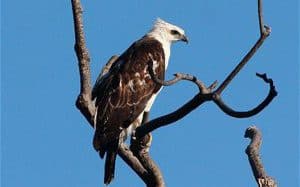 Although Flores Eagle endemically live in Flores, Nusa Tenggara, we can still have a chance to find this bird around islands of Sumbawa, Lombok, Komodo, Paloe, Satonda, and Rinca.
Although Flores Eagle endemically live in Flores, Nusa Tenggara, we can still have a chance to find this bird around islands of Sumbawa, Lombok, Komodo, Paloe, Satonda, and Rinca.
It has a middle-size bird approximately 55 cm in size, typically white head with a bit of brown scratches on it.
However unfortunately by now, Flores Eagle has been written as critically endangered (with red status) with no more than 250 heads left.
4. Elang Jawa (Spizaetus bartelsi)
 Javanese Eagle has the typical brownish crest on its head as its famous signature. It lives naturally on Java island, but many institutions started to breed it ex situ in in captivity or the national safari park. It now is becoming endangered because people keep searching for it to be collected.
Javanese Eagle has the typical brownish crest on its head as its famous signature. It lives naturally on Java island, but many institutions started to breed it ex situ in in captivity or the national safari park. It now is becoming endangered because people keep searching for it to be collected.
Then, it normally only spawn 1 egg for 2 years and is finally laying out little birds after being incubated for 40-50 days. Imagine how hard it is to breed it while many people still hunting it down?
5. Gagak Banggai (Corvus unicolor)
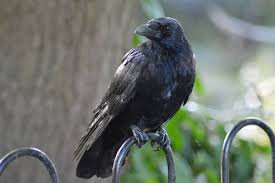 Banggai Crow is an endemic creature of Banggai, Central Sulawesi. It has maximum 40 cm body size, with typical black fur just like any other crows, and lives inside forest.
Banggai Crow is an endemic creature of Banggai, Central Sulawesi. It has maximum 40 cm body size, with typical black fur just like any other crows, and lives inside forest.
Due to its small and single population (contained in only one location) and the threat of forest degradation as its natural habitat, this type of crow is evaluated by the IUCN Redlist in ‘Critically Endangered’ conservation status since 2005.
6. Jalak Bali (Leucopsar rothschildi)
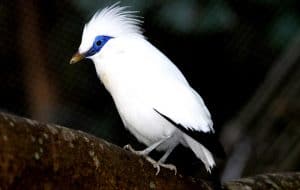 Jalak Bali is a very lovely bird with white beautiful furs with a bit of blue strikes around its eyes and crested white on the back of the head. It is the only Bali island’s endemic animal after Bali Tigger has been announced as extinct.
Jalak Bali is a very lovely bird with white beautiful furs with a bit of blue strikes around its eyes and crested white on the back of the head. It is the only Bali island’s endemic animal after Bali Tigger has been announced as extinct.
We can still find Jalak Bali at the west part of Bali island if we happen to go there sometime in the future.
7. Merak Hijau (Pavo muticus)
 According to CITES (the Convention on International Trade in Endangered Species of Wildlife Fauna and Flora) in the Ministry of Forestry (2006), Merak Hijau or Green Peacocks are categorized into Appendix II, meaning that this type of bird trade should be controlled, among others through quota system and supervision. Read more about Merak Bird
According to CITES (the Convention on International Trade in Endangered Species of Wildlife Fauna and Flora) in the Ministry of Forestry (2006), Merak Hijau or Green Peacocks are categorized into Appendix II, meaning that this type of bird trade should be controlled, among others through quota system and supervision. Read more about Merak Bird
The reason why people keep hunting them down is because of its very long lovely tail cover. You need to see it yourselves to realize how magnificent it is. Visit its endemic place at Alas Purwo National Park, East Java. It is also estimated to still exist in Ujung Kulon National Park, and Meru Betiri National Park. Visit those places for proof!
8. Kasuari Gelambir Ganda (Casuarius casuarius)
 Kasuari Gelambir Ganda, or Cassowary Double Gelambir in English, is one of those big (up to 170cm) and unique bird originally from Irian and Seram island, Maluku.
Kasuari Gelambir Ganda, or Cassowary Double Gelambir in English, is one of those big (up to 170cm) and unique bird originally from Irian and Seram island, Maluku.
Meanwhile, it can’t fly, but it has big and strong feet with ability to run at high-speed when in danger. This Cassowary has blue head and neck that differentiate it from other species. Status: IUCN Red List.
9. Kakatua Kecil Jambul Kuning (Cacatua sulphurea)
 This bird is almost all the feathers are white. In his head was a yellow crest that could be enforced.
This bird is almost all the feathers are white. In his head was a yellow crest that could be enforced.
The yellow-crested cockatoo distribution area is the Lesser Sunda Islands, Sulawesi, Bali and Timor, where there are still primary and secondary forests. Intelligent and avid poultry feed consists of whole grains, nuts, and various fruits.
10. Merpati Hutan Perak (Columba argentina)
 Merpati Silver Forest is around 40 cm in size with pale gray furs. The wings are black, the tail and the lower body are gray.
Merpati Silver Forest is around 40 cm in size with pale gray furs. The wings are black, the tail and the lower body are gray.
Spreading of this bird covers Simeulue island, Mentawai, Riau, Anambas, northern Natuna and Karimata island in the western tip of Borneo. Read more about Dangerous Animals in Indonesia, Animals of Borneo, and Endangered Animals in Indonesia.
11. Perkici Buru (Charmosyna toxopei)
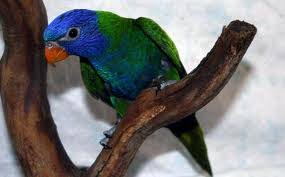 This endemic bird of Buru island has a crooked beak, with blue crown on its head, green-yellowish furs, reddish base of tail, and a small body sizes (only about 16 cm). It sounds “ti-ti-ti-ti” loudly and shrilly.
This endemic bird of Buru island has a crooked beak, with blue crown on its head, green-yellowish furs, reddish base of tail, and a small body sizes (only about 16 cm). It sounds “ti-ti-ti-ti” loudly and shrilly.
You may want to read about Native Animals in Indonesia and Endangered Sumatran Elephants
12. Trulek Jawa (Vanellus macropterus)
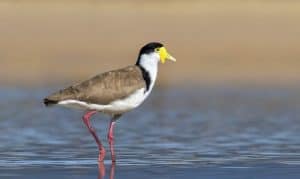 Trulek Java is a medium size bird, about 28 cm in height. The coat is gray-brown with a black head.
Trulek Java is a medium size bird, about 28 cm in height. The coat is gray-brown with a black head.
Some areas allegedly inhabited by this endemic include Forest Sawangan, Petungkriyono, Pekalongan (Central Java), forest of Ungaran Mountain (Central Java) and Merubetiri, Jember (East Java).
13. Tokhtor Sumatera (Carpococcyx viridis)
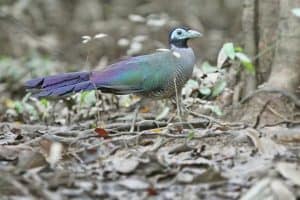 This species is a sibling of two other Tokhtor species in the world, which are Tokhtor Kalimantan (Carpococcyx radiceus) from Kalimatan and Coral-billed Ground-cuckoo (Carpococcyx renauldi) from Vietnam.
This species is a sibling of two other Tokhtor species in the world, which are Tokhtor Kalimantan (Carpococcyx radiceus) from Kalimatan and Coral-billed Ground-cuckoo (Carpococcyx renauldi) from Vietnam.
Tokhtor Sumatera bird is a groundwater bird with a large body size reaches 60 cm, lives on the ground, feeds on small vertebrates and large invertebrates, and is endangered and shy.
After knowing several lovely birds from list above, which one catch your attention the most? All the species are actually living their live to the fullest on a proper habitat in Indonesia. But, unfortunately many of their natural habitual places are slowly vanishing one by one and that’s the reason why most of the species on the list now having an “endangered animal” status on them.
So, we warn you to stop collecting and confining birds as your collection at home. Let them live and breed happily out there, so then our next generation will be able to learn about them, too. Happy exploring the natural beauties of Indonesia and keep on being wise, nature lovers!
